基础组件
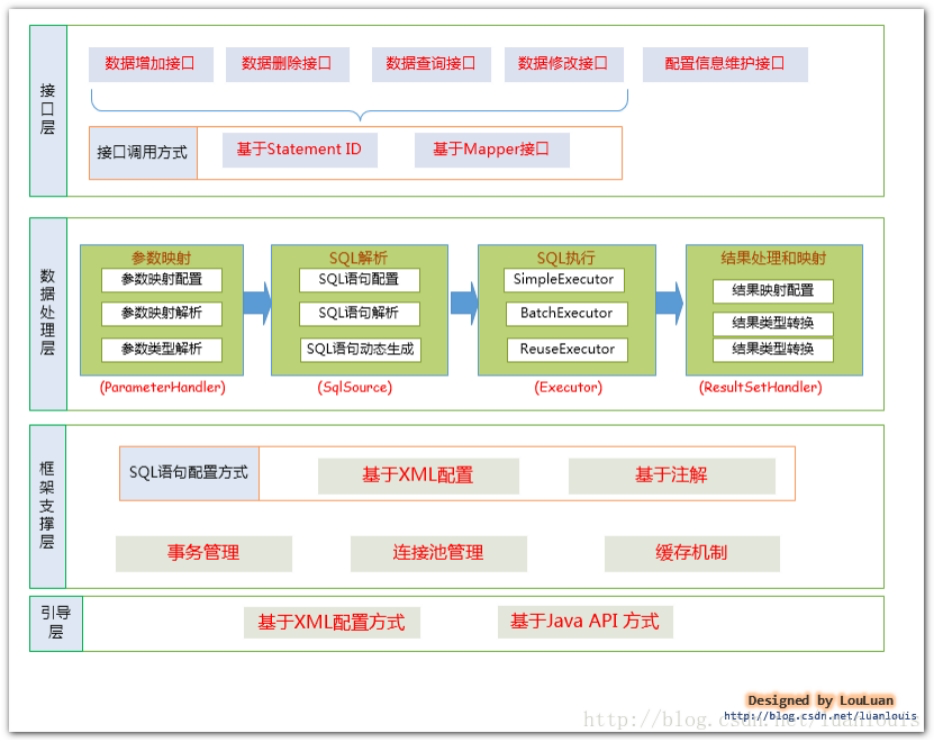
SqlSession
SqlSession是mybatis面向用户的一个类,使用如下:
1
2
3
4
5
6
7
8
9
10
11
12
13
| @Test
@SneakyThrows
public void testSelect() {
try (Reader reader = Resources.getResourceAsReader("mybatis-config.xml")) {
SqlSessionFactory sqlSessionFactory = new SqlSessionFactoryBuilder().build(reader);
SqlSession sqlSession = sqlSessionFactory.openSession();
final List<Object> selectAll = sqlSession.selectList("selectAll", null, new RowBounds(10,20));
System.out.println("selectAll = " + selectAll);
}
}
|
SqlSession创建过程:
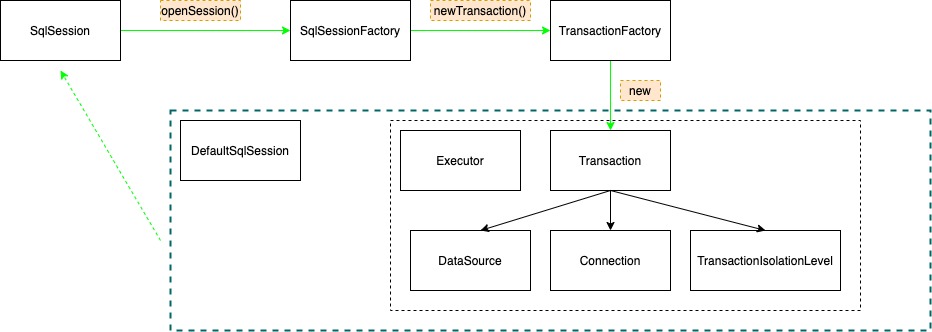
执行过程:
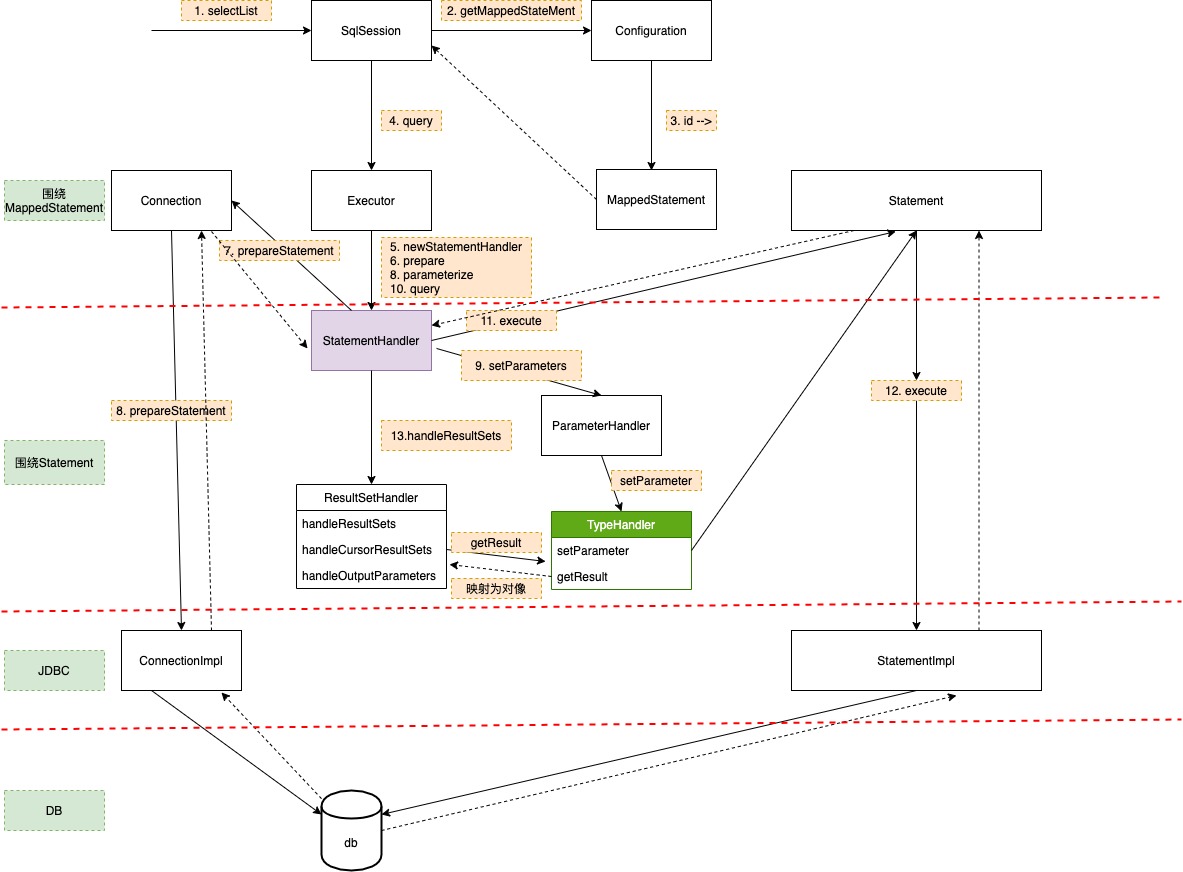
Executor
这一层提供的接口主要是针对MappedStatement的:
1
2
3
4
5
6
7
8
9
10
11
12
13
14
15
16
17
18
19
20
21
22
23
24
25
26
27
28
29
30
31
32
33
34
35
36
37
38
|
public interface Executor {
ResultHandler NO_RESULT_HANDLER = null;
int update(MappedStatement ms, Object parameter) throws SQLException;
<E> List<E> query(MappedStatement ms, Object parameter, RowBounds rowBounds, ResultHandler resultHandler, CacheKey cacheKey, BoundSql boundSql) throws SQLException;
<E> List<E> query(MappedStatement ms, Object parameter, RowBounds rowBounds, ResultHandler resultHandler) throws SQLException;
<E> Cursor<E> queryCursor(MappedStatement ms, Object parameter, RowBounds rowBounds) throws SQLException;
List<BatchResult> flushStatements() throws SQLException;
void commit(boolean required) throws SQLException;
void rollback(boolean required) throws SQLException;
CacheKey createCacheKey(MappedStatement ms, Object parameterObject, RowBounds rowBounds, BoundSql boundSql);
boolean isCached(MappedStatement ms, CacheKey key);
void clearLocalCache();
void deferLoad(MappedStatement ms, MetaObject resultObject, String property, CacheKey key, Class<?> targetType);
Transaction getTransaction();
void close(boolean forceRollback);
boolean isClosed();
void setExecutorWrapper(Executor executor);
}
|
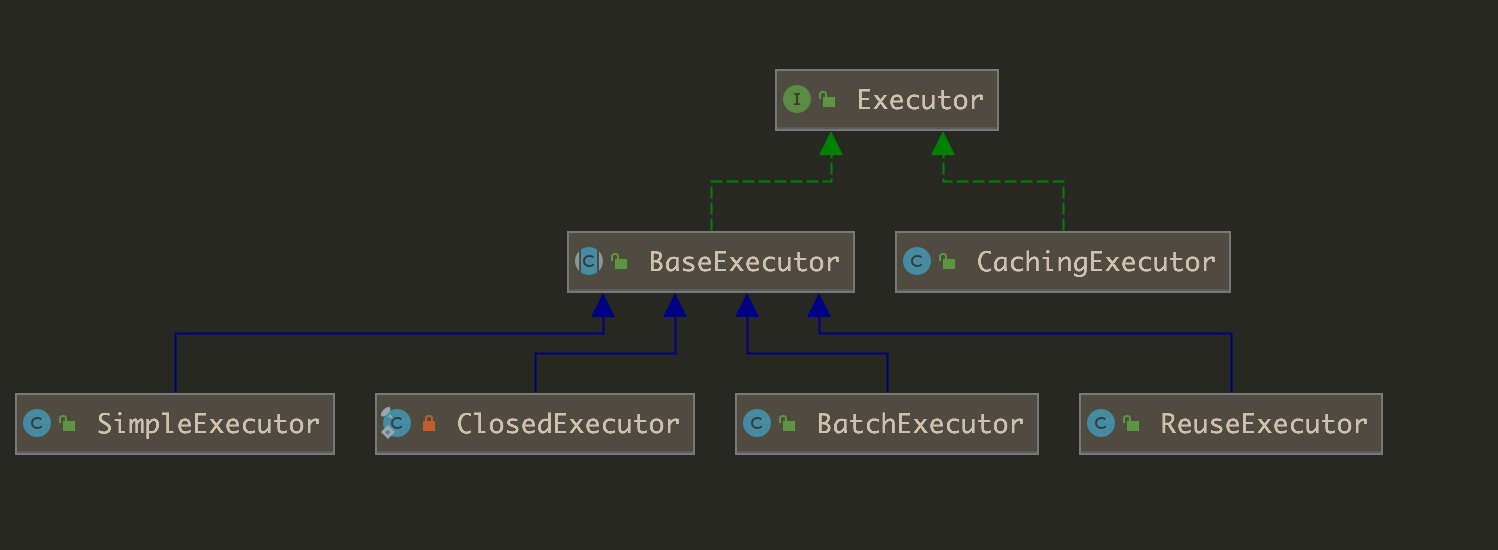
结果缓存
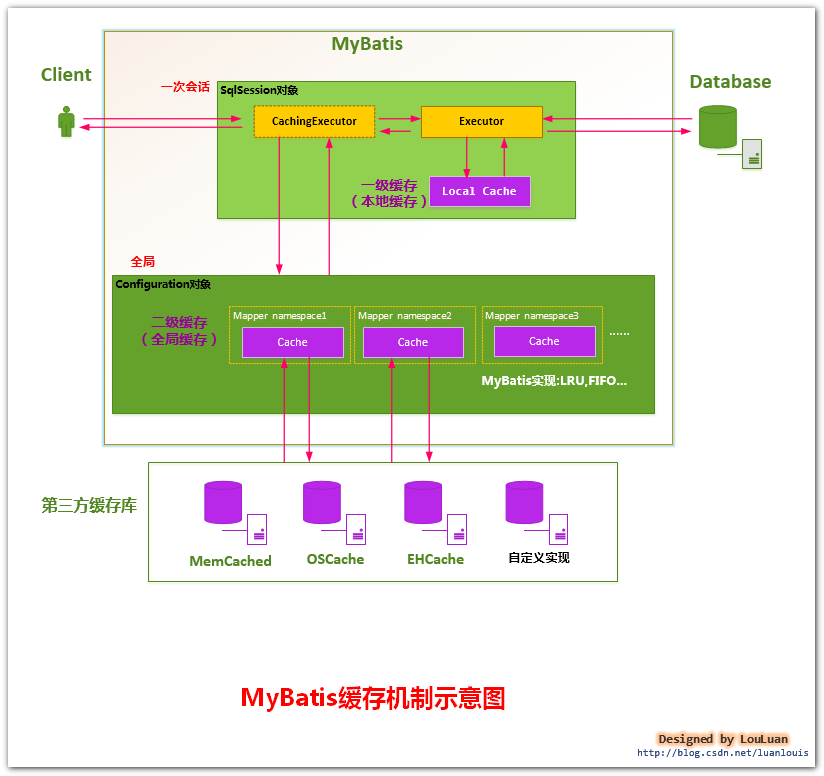
在创建Session的时候,可以指定使用哪种executor
1
2
3
4
5
6
7
8
9
10
11
12
13
14
15
16
17
18
19
20
21
|
public Executor newExecutor(Transaction transaction, ExecutorType executorType) {
executorType = executorType == null ? defaultExecutorType : executorType;
executorType = executorType == null ? ExecutorType.SIMPLE : executorType;
Executor executor;
if (ExecutorType.BATCH == executorType) {
executor = new BatchExecutor(this, transaction);
} else if (ExecutorType.REUSE == executorType) {
executor = new ReuseExecutor(this, transaction);
} else {
executor = new SimpleExecutor(this, transaction);
}
if (cacheEnabled) {
executor = new CachingExecutor(executor);
}
executor = (Executor) interceptorChain.pluginAll(executor);
return executor;
}
|
Session级别的缓存(一级缓存)
一级缓存默认打开
MyBatis的一级缓存最大范围是SqlSession内部,有多个SqlSession或者分布式的环境下,数据库写操作会引起脏数据,建议设定缓存级别为Statement。
1
| configuration.setLocalCacheScope(LocalCacheScope.valueOf(props.getProperty("localCacheScope", "SESSION")));
|
没有配置默认就是session级别的,配置示例:
1
| <setting name="localCacheScope" value="SESSION"/>
|
Executor是跟session绑定的,所以这个缓存是session级别的,也就是连接级别的。连接关闭之后,这个缓存也就消失了。
1
2
3
4
5
6
7
8
9
10
11
12
13
14
15
16
17
18
19
20
21
22
23
24
25
26
27
28
29
30
31
32
33
34
35
36
37
38
39
40
41
42
43
44
45
46
47
48
49
50
51
52
53
54
55
56
57
58
59
60
61
62
63
64
65
|
@Override
public <E> List<E> query(MappedStatement ms, Object parameter, RowBounds rowBounds, ResultHandler resultHandler) throws SQLException {
BoundSql boundSql = ms.getBoundSql(parameter);
CacheKey key = createCacheKey(ms, parameter, rowBounds, boundSql);
return query(ms, parameter, rowBounds, resultHandler, key, boundSql);
}
@Override
public <E> List<E> query(MappedStatement ms, Object parameter, RowBounds rowBounds, ResultHandler resultHandler, CacheKey key, BoundSql boundSql) throws SQLException {
ErrorContext.instance().resource(ms.getResource()).activity("executing a query").object(ms.getId());
if (closed) {
throw new ExecutorException("Executor was closed.");
}
if (queryStack == 0 && ms.isFlushCacheRequired()) {
clearLocalCache();
}
List<E> list;
try {
queryStack++;
list = resultHandler == null ? (List<E>) localCache.getObject(key) : null;
if (list != null) {
handleLocallyCachedOutputParameters(ms, key, parameter, boundSql);
} else {
list = queryFromDatabase(ms, parameter, rowBounds, resultHandler, key, boundSql);
}
} finally {
queryStack--;
}
if (queryStack == 0) {
for (DeferredLoad deferredLoad : deferredLoads) {
deferredLoad.load();
}
deferredLoads.clear();
if (configuration.getLocalCacheScope() == LocalCacheScope.STATEMENT) {
clearLocalCache();
}
}
return list;
}
private <E> List<E> queryFromDatabase(MappedStatement ms, Object parameter, RowBounds rowBounds, ResultHandler resultHandler, CacheKey key, BoundSql boundSql) throws SQLException {
List<E> list;
localCache.putObject(key, EXECUTION_PLACEHOLDER);
try {
list = doQuery(ms, parameter, rowBounds, resultHandler, boundSql);
} finally {
localCache.removeObject(key);
}
localCache.putObject(key, list);
if (ms.getStatementType() == StatementType.CALLABLE) {
localOutputParameterCache.putObject(key, parameter);
}
return list;
}
|
Statement级别的缓存(二级缓存)
CachingExecutor加了一层Statement级别的缓存,其他的逻辑都是委托给其他的Executor来实现的。
1
2
3
4
5
6
7
8
9
10
11
12
13
14
15
16
17
18
19
20
21
22
23
24
25
|
@Override
public <E> List<E> query(MappedStatement ms, Object parameterObject, RowBounds rowBounds, ResultHandler resultHandler, CacheKey key, BoundSql boundSql)
throws SQLException {
Cache cache = ms.getCache();
if (cache != null) {
flushCacheIfRequired(ms);
if (ms.isUseCache() && resultHandler == null) {
ensureNoOutParams(ms, boundSql);
@SuppressWarnings("unchecked")
List<E> list = (List<E>) tcm.getObject(cache, key);
if (list == null) {
list = delegate.query(ms, parameterObject, rowBounds, resultHandler, key, boundSql);
tcm.putObject(cache, key, list);
}
return list;
}
}
return delegate.query(ms, parameterObject, rowBounds, resultHandler, key, boundSql);
}
|
实际处理类的逻辑:
1
2
3
4
5
6
7
8
9
10
11
12
13
14
15
16
|
@Override
public <E> List<E> doQuery(MappedStatement ms, Object parameter, RowBounds rowBounds, ResultHandler resultHandler, BoundSql boundSql) throws SQLException {
Statement stmt = null;
try {
Configuration configuration = ms.getConfiguration();
StatementHandler handler = configuration.newStatementHandler(wrapper, ms, parameter, rowBounds, resultHandler, boundSql);
stmt = prepareStatement(handler, ms.getStatementLog());
return handler.query(stmt, resultHandler);
} finally {
closeStatement(stmt);
}
}
|
Cache的实现使用了装饰者模式:
SynchronizedCache -> LoggingCache -> SerializedCache -> LruCache -> PerpetualCache
以下是具体这些Cache实现类的介绍,他们的组合为Cache赋予了不同的能力。
SynchronizedCache:同步Cache,实现比较简单,直接使用synchronized修饰方法。LoggingCache:日志功能,装饰类,用于记录缓存的命中率,如果开启了DEBUG模式,则会输出命中率日志。SerializedCache:序列化功能,将值序列化后存到缓存中。该功能用于缓存返回一份实例的Copy,用于保存线程安全。LruCache:采用了Lru算法的Cache实现,移除最近最少使用的Key/Value。PerpetualCache: 作为为最基础的缓存类,底层实现比较简单,直接使用了HashMap。
二级缓存跨session存在,有很大的风险会读到错误的数据。而且大部分的互联网应用都是分布式的,一般不共享状态,可以水平扩展;但是本地缓存打破了无状态下,很有可能会读到错误的数据,应该慎重使用。
PreparedStatement缓存(PSCache)
又叫PSCache,这里对应的是ReuseExecutor,这个缓存也是Session级别的。除了在Mybatis这一层做缓存,还可以在MySQL驱动和MysqlServer做缓存,参见jdbc预编译缓存加速sql执行 | KL’s blog
1
2
3
4
5
6
7
8
9
10
11
12
13
14
15
16
17
18
19
20
21
22
23
24
25
26
27
28
29
30
31
32
33
34
|
private Statement prepareStatement(StatementHandler handler, Log statementLog) throws SQLException {
Statement stmt;
BoundSql boundSql = handler.getBoundSql();
String sql = boundSql.getSql();
if (hasStatementFor(sql)) {
stmt = getStatement(sql);
applyTransactionTimeout(stmt);
} else {
Connection connection = getConnection(statementLog);
stmt = handler.prepare(connection, transaction.getTimeout());
putStatement(sql, stmt);
}
handler.parameterize(stmt);
return stmt;
}
private boolean hasStatementFor(String sql) {
try {
return statementMap.keySet().contains(sql) && !statementMap.get(sql).getConnection().isClosed();
} catch (SQLException e) {
return false;
}
}
private Statement getStatement(String s) {
return statementMap.get(s);
}
private void putStatement(String sql, Statement stmt) {
statementMap.put(sql, stmt);
}
|
StatementHandler
StatementHandler主要是跟javax里的Statement打交道的,相当于对Statement的操作进行了一层封装,也是mybatis和jdbc的一个隔离层。
接口:
1
2
3
4
5
6
7
8
9
10
11
12
13
14
15
16
17
18
19
20
21
22
23
24
25
26
27
28
|
public interface StatementHandler {
Statement prepare(Connection connection, Integer transactionTimeout)
throws SQLException;
void parameterize(Statement statement)
throws SQLException;
void batch(Statement statement)
throws SQLException;
int update(Statement statement)
throws SQLException;
<E> List<E> query(Statement statement, ResultHandler resultHandler)
throws SQLException;
<E> Cursor<E> queryCursor(Statement statement)
throws SQLException;
BoundSql getBoundSql();
ParameterHandler getParameterHandler();
}
|
可以看出,接口中的参数,都是Statement而不是mybatis自己的MappedStatement
继承关系:
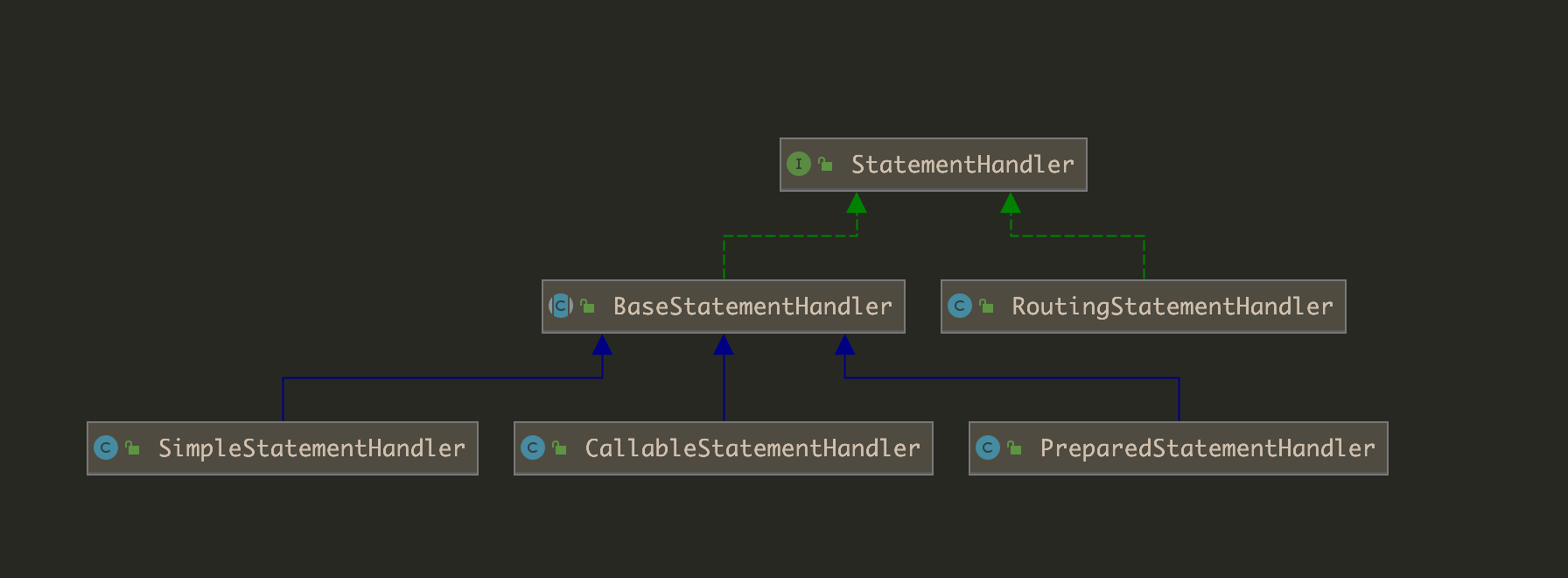
其中RoutingStatementHandler就是用来路由的,根据查询的类型路由到SimpleStatementHandler、CallableStatementHandler、PreparedStatementHandler
1
2
3
4
5
6
7
8
9
10
11
12
13
14
15
16
| public RoutingStatementHandler(Executor executor, MappedStatement ms, Object parameter, RowBounds rowBounds, ResultHandler resultHandler, BoundSql boundSql) {
switch (ms.getStatementType()) {
case STATEMENT:
delegate = new SimpleStatementHandler(executor, ms, parameter, rowBounds, resultHandler, boundSql);
break;
case PREPARED:
delegate = new PreparedStatementHandler(executor, ms, parameter, rowBounds, resultHandler, boundSql);
break;
case CALLABLE:
delegate = new CallableStatementHandler(executor, ms, parameter, rowBounds, resultHandler, boundSql);
break;
default:
throw new ExecutorException("Unknown statement type: " + ms.getStatementType());
}
}
|
TypeHandler
TypeHandler主要负责类型转换,类似spring的ConversionService, 主要用于两个地方,一个是设置PrepareStatement,占位符对应的参数;一个是将ResultSet返回的结果集转换成对象。
1
2
3
4
5
6
7
8
9
10
11
12
13
14
|
public interface TypeHandler<T> {
void setParameter(PreparedStatement ps, int i, T parameter, JdbcType jdbcType) throws SQLException;
T getResult(ResultSet rs, String columnName) throws SQLException;
T getResult(ResultSet rs, int columnIndex) throws SQLException;
T getResult(CallableStatement cs, int columnIndex) throws SQLException;
}
|
ParameterHandler
比如数据库里面存的是VARCHAR,传给mybatis的是一个Bean对象,就可以在这一层做一个转换:
1
2
3
4
5
6
7
8
9
10
| @Override
public void setNonNullParameter(PreparedStatement ps, int i, T parameter, JdbcType jdbcType) throws SQLException {
try {
ps.setString(i, ObjectUtil.toJson(parameter));
} catch (JsonProcessingException e) {
throw new RuntimeException(e);
}
}
|
默认实现org.apache.ibatis.scripting.defaults.DefaultParameterHandler
1
2
3
4
5
6
7
8
9
10
11
12
13
14
15
16
17
18
19
20
21
22
23
24
25
26
27
28
29
30
31
32
33
34
35
36
37
38
39
|
@Override
public void setParameters(PreparedStatement ps) {
ErrorContext.instance().activity("setting parameters").object(mappedStatement.getParameterMap().getId());
List<ParameterMapping> parameterMappings = boundSql.getParameterMappings();
if (parameterMappings != null) {
for (int i = 0; i < parameterMappings.size(); i++) {
ParameterMapping parameterMapping = parameterMappings.get(i);
if (parameterMapping.getMode() != ParameterMode.OUT) {
Object value;
String propertyName = parameterMapping.getProperty();
if (boundSql.hasAdditionalParameter(propertyName)) {
value = boundSql.getAdditionalParameter(propertyName);
} else if (parameterObject == null) {
value = null;
} else if (typeHandlerRegistry.hasTypeHandler(parameterObject.getClass())) {
value = parameterObject;
} else {
MetaObject metaObject = configuration.newMetaObject(parameterObject);
value = metaObject.getValue(propertyName);
}
TypeHandler typeHandler = parameterMapping.getTypeHandler();
JdbcType jdbcType = parameterMapping.getJdbcType();
if (value == null && jdbcType == null) {
jdbcType = configuration.getJdbcTypeForNull();
}
try {
typeHandler.setParameter(ps, i + 1, value, jdbcType);
} catch (TypeException e) {
throw new TypeException("Could not set parameters for mapping: " + parameterMapping + ". Cause: " + e, e);
} catch (SQLException e) {
throw new TypeException("Could not set parameters for mapping: " + parameterMapping + ". Cause: " + e, e);
}
}
}
}
}
|
ResultSetHandler
用于转换JDBC返回的ResultSet对象为Statement中定义的返回值类型。
1
2
3
4
5
6
7
8
9
10
11
12
13
14
15
16
17
18
19
20
21
22
23
|
public interface ResultSetHandler {
<E> List<E> handleResultSets(Statement stmt) throws SQLException;
<E> Cursor<E> handleCursorResultSets(Statement stmt) throws SQLException;
void handleOutputParameters(CallableStatement cs) throws SQLException;
}
public interface ResultHandler<T> {
void handleResult(ResultContext<? extends T> resultContext);
}
|
默认实现:
1
2
3
4
5
6
7
8
9
10
11
12
13
14
15
16
17
18
19
20
21
22
23
24
25
26
27
28
29
30
31
32
33
34
35
36
37
38
|
private void handleResultSet(ResultSetWrapper rsw, ResultMap resultMap, List<Object> multipleResults, ResultMapping parentMapping) throws SQLException {
try {
if (parentMapping != null) {
handleRowValues(rsw, resultMap, null, RowBounds.DEFAULT, parentMapping);
} else {
if (resultHandler == null) {
DefaultResultHandler defaultResultHandler = new DefaultResultHandler(objectFactory);
handleRowValues(rsw, resultMap, defaultResultHandler, rowBounds, null);
multipleResults.add(defaultResultHandler.getResultList());
} else {
handleRowValues(rsw, resultMap, resultHandler, rowBounds, null);
}
}
} finally {
closeResultSet(rsw.getResultSet());
}
}
private Object createUsingConstructor(ResultSetWrapper rsw, Class<?> resultType, List<Class<?>> constructorArgTypes, List<Object> constructorArgs, Constructor<?> constructor) throws SQLException {
boolean foundValues = false;
for (int i = 0; i < constructor.getParameterTypes().length; i++) {
Class<?> parameterType = constructor.getParameterTypes()[i];
String columnName = rsw.getColumnNames().get(i);
TypeHandler<?> typeHandler = rsw.getTypeHandler(parameterType, columnName);
Object value = typeHandler.getResult(rsw.getResultSet(), columnName);
constructorArgTypes.add(parameterType);
constructorArgs.add(value);
foundValues = value != null || foundValues;
}
return foundValues ? objectFactory.create(resultType, constructorArgTypes, constructorArgs) : null;
}
|
参考






